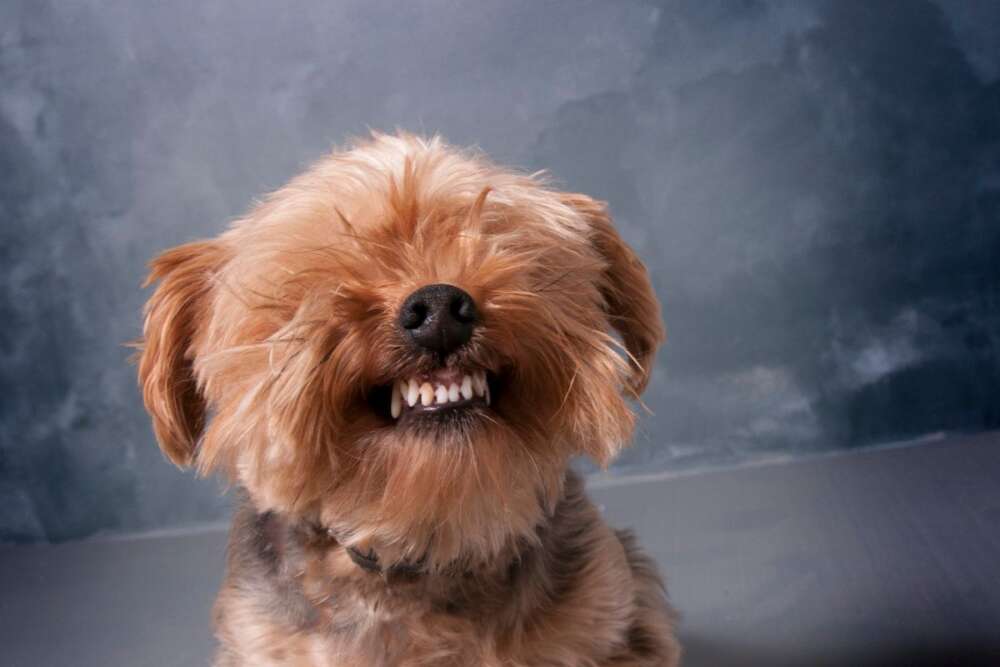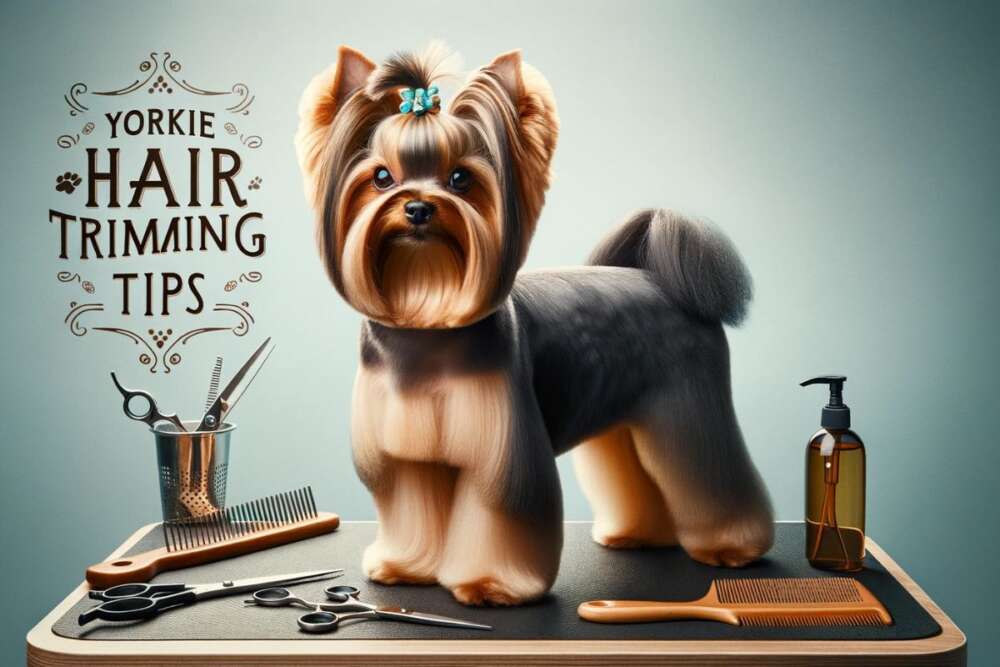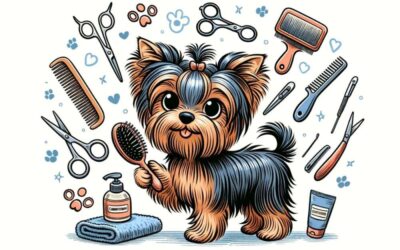Introduction
Ah, the Yorkie! These little bundles of joy aren’t just known for their spunky personalities, but also for their long, silky coats. While the flowing tresses of a Yorkshire Terrier are undeniably beautiful, they do require a bit of upkeep. If you’ve found yourself wondering how to keep your Yorkie looking its best, you’re in the right place. Let’s dive into some hair trimming tips that’ll have your Yorkie turning heads wherever they go.
Tools You’ll Need
Before you even think about giving your Yorkie a trim, it’s crucial to have the right tools on hand.
- Clippers and Scissors: Invest in a good pair of clippers designed for dogs. They’re sharper and safer than regular scissors. Alongside clippers, a pair of blunt-end scissors can help with precision cuts, especially around the face.
Tool Purpose Note Dog Clippers For overall body trimming Look for quiet ones to reduce anxiety. Blunt-end Scissors For detailed work, like around the eyes Ensures safety during close trims. - Combs and Brushes: Your Yorkie’s long hair can tangle easily. A steel comb will help detangle, while a slicker brush can keep their coat smooth and shiny.
Tool Purpose Note Steel Comb Detangling tougher knots Start from the tips, working your way to the base. Slicker Brush Smoothing the coat Great for daily grooming routines. - Grooming Table: While not strictly necessary, having a dedicated grooming table can make the process easier and more comfortable for both you and your Yorkie.
Preparing Your Yorkie for Trimming
Now, with the tools in hand, it’s time to set the stage for a successful trim.
- Setting the Mood: Yorkies can be a bit skittish. Ensure the environment is calm. Maybe play some soft music, and always use a gentle voice to soothe any nervousness.
- Brushing Out Tangles: Before you get to trimming, you’ll want to ensure that your Yorkie’s coat is free of tangles. Remember that steel comb? It’s time to put it to work. Starting from the tips, gently work your way to the base of any knots to minimize pulling.
- Deciding on a Hair Style: Believe it or not, there are several styles suitable for Yorkies! From the “puppy cut” to the full-length “show cut”, decide in advance which look you’re going for. It’ll make the process smoother.
Step-by-Step Guide to Trimming
Let’s get down to the main event!
- Starting with the Face: Always begin with the hair on the face because it’s the most delicate. Using your blunt-end scissors, carefully trim around the eyes, ensuring no stray hairs are poking into them. Remember, short and steady snips are the key.Important: Always point the scissors away from your Yorkie’s eyes!
Trimming the Body
Your Yorkie’s coat, if left unattended, can become quite long. While some pet parents adore the elegant, flowing appearance, it’s essential to trim it occasionally to maintain cleanliness and comfort.
- Decide on the Length: Some prefer a closer trim, akin to the “puppy cut,” which keeps the hair at a manageable length. Others might opt for a longer look. Whatever your preference, ensure it’s consistent all over the body.
- Use the Clippers: With your clippers in hand, start from the neck and move down the body. Ensure you’re moving against the grain of the hair for a smooth cut. Remember, it’s always better to cut less at first; you can always go shorter if needed.
- Be Mindful of Sensitive Areas: The belly and chest areas can be a bit sensitive. Approach these areas gently, using the scissors for precision if required.
Attention to the Paws and Tail
The paws and tail might seem like minor areas, but they require as much attention as the face and body.
- Paws: Start by spreading your Yorkie’s toes apart. Carefully trim the hair that grows between the pads. This is essential, as these hairs can trap dirt and debris, leading to discomfort or potential infections.
Area Tool Tip Paws Blunt-end Scissors Always cut in the direction away from the pads to avoid nicks. - Tail: The tail should be trimmed to look neat but not too short. It’s a Yorkie’s flag of pride, after all! Keep the hair on the tail slightly longer than the body, tapering to a point at the end.
Common Mistakes to Avoid
As with any skill, practice makes perfect. However, it’s good to be aware of common pitfalls so you can avoid them from the get-go.
- Cutting Too Short: It might seem efficient to cut the hair very short, but it can lead to your Yorkie feeling exposed or even getting sunburned. Always leave at least half an inch of hair.
- Ignoring the Ears and Eyes: These areas are crucial! Overgrown hair can obscure vision or cause ear infections. Always ensure they’re neatly trimmed.
- Forgetting to Reward: Trimming can be a stressful experience for some dogs. Make it a positive one by offering treats and lots of praise!
Hair trimming is more than just a cosmetic routine for Yorkies; it’s about ensuring their comfort and health. With the right tools, a gentle touch, and a sprinkle of patience, your Yorkie will not only look like a showstopper but also feel their absolute best. So, the next time your Yorkie’s hair starts to look a tad untamed, remember these tips, and happy grooming!
Maintaining the Trim
Once your Yorkie is looking dapper, it’s crucial to maintain that fresh trim. Let’s explore how you can keep your little friend looking top-notch.
- Daily Brushing: Consistent brushing not only keeps the coat looking sleek but also helps in removing any tangles or knots. Dedicate a few minutes every day for this routine. Your Yorkie will not only enjoy the attention but also stay tangle-free.
- Regular Bathing: Bathing your Yorkie once every few weeks is essential. Use a gentle dog shampoo and ensure that you rinse out all the soap. Bathing helps remove accumulated dirt and keeps the coat shiny.
- Routine Touch-Ups: Even with a full trim, you might notice some stray hairs here and there over time. Keep your blunt-end scissors handy for occasional touch-ups, especially around the eyes and paws.
Benefits of Regular Hair Trimming
Apart from the obvious aesthetic appeal, regular trims offer a host of benefits:
- Health and Comfort: Long hairs, especially around the eyes and ears, can lead to infections. Regular trimming keeps these issues at bay.
- Appearance and Style: A well-groomed Yorkie is a sight to behold. Their shiny, sleek coat not only adds to their charm but also makes them feel good.
- Bonding Experience: The grooming session can be a special time between you and your pet. It’s a chance to bond, build trust, and spend quality time together.
Conclusion
Yorkie hair trimming is an art that requires patience and the right tools. A comprehensive guide to hair trimming will help you choose the appropriate brush for yorkies and scissors. After a trimming session, dressing your Yorkie in comfortable yorkie dog clothes can help prevent them from feeling chilly. Also, understanding common yorkie health issues can be beneficial when grooming, as it allows you to check for any signs of skin or coat problems.
FAQs
How often should I trim my Yorkie’s hair?
Ideally, a full trim every 6-8 weeks is sufficient. However, routine touch-ups in between can keep them looking neat.
Can I use human hair products on my Yorkie?
It’s recommended to use products formulated specifically for dogs. Their pH level and ingredients are tailored to a dog’s needs.
My Yorkie is scared of the clippers. What should I do?
Start by letting them get used to the sound. Turn on the clippers and let them investigate. Offer treats and positive reinforcement. Over time, they’ll associate the noise with positive experiences.
Do I need to trim my Yorkie’s hair during winter?
Yes, while the coat provides warmth, excessively long hair can trap moisture and lead to discomfort or infections.
Is it okay to leave the hair around the eyes long?
It’s essential to trim the hair around the eyes. Long hair can irritate the eyes and even affect vision.

As a lifelong dog lover, I fell in love with Yorkies for their spunky personalities, intelligence, and unwavering loyalty.
As a dedicated Yorkie owner, I have spent years learning about the breed and how to provide the best possible care for them. From finding the proper diet to exercise, and so much more! I take every aspect of my Yorkie’s life seriously.
In addition to being a loving dog parent, I’m an avid blogger, sharing my experiences and insights on all things Yorkie-related. From training tips to grooming advice, Yorkieclothing.com is a go-to resource for other Yorkie owners worldwide.




